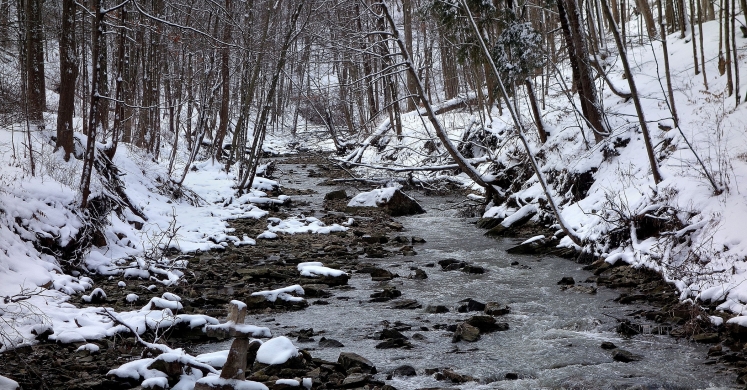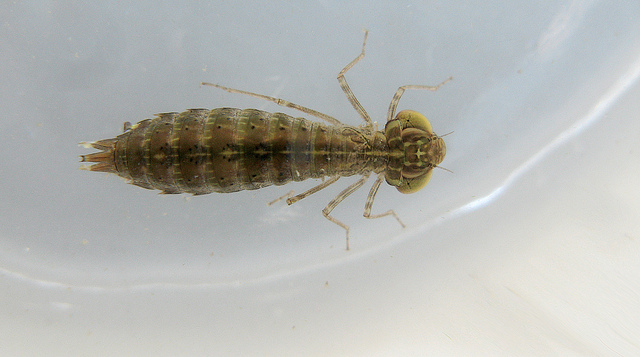Blog

#bioPGH Blog: Insects Under the Ice
 A resource of Biophilia: Pittsburgh, #bioPGH is a weekly blog and social media series that aims to encourage both children and adults to reconnect with nature and enjoy what each of our distinctive seasons has to offer.
A resource of Biophilia: Pittsburgh, #bioPGH is a weekly blog and social media series that aims to encourage both children and adults to reconnect with nature and enjoy what each of our distinctive seasons has to offer.
This week may have started with a surprise snow, but the slightly warmer temperatures remind us that spring will soon return! It seems strange to think that even in the coldest of winter days, our streams and water ways still teem with life and activity. Below a layer of ice the bustle of living things is still there. Let’s explore some of the more overlooked winter water creatures in our area—some aquatic insects!
Pennsylvania is home to roughly 300 species of mayflies, but unless you’re a fly fishing enthusiast, many of us only really notice mayflies during their short but dramatic emergence in early summer. In 2012, a huge emergence of mayflies startled Pittsburgh, especially the North Shore. Swarms of the harmless, winged insects were drawn to the lights of PNC Park, created a traffic hazard on the Three Sisters bridges, and generally surprised anyone out for a walk along the rivers—there were so many! That experience with mayflies was exciting (from a naturalist’s perspective), but it represented only a small percentage of a mayfly life span. In fact, mayflies only live 1-2 days as an adult! Most of a mayfly’s life (generally 1-2 years) is spent as an immature nymph. Right now, even in this chilly February weather, mayfly nymphs are going about their normal day in the freezing waters of our streams and rivers. The nymphs are perfectly suited to a cold aquatic life, and they even have gills—though the exact anatomy varies from species to species. Their preferred foods range from plant materials to algae, but they will eat a wide variety of decaying organic materials (called detritus) found on the bottom of the water way.
Other little aquatic invertebrate friends that are cruising in our rivers and streams this time of year are stoneflies (though a few of the early birds have begun to emerge already.) Like the mayfly, stoneflies spend most of their lives as immature nymph, sometimes living up to four years in this stage depending on the species. They spend a few weeks as adults, longer than a mayfly, but their primary goal is to reproduce before their short adulthood is over. As nymphs, they tend to live on the underside of rocks and stones in streams, making it difficult to find them.
Odonates, the order of insects that include dragonflies and damselflies, are another group of insects that are also quite busy as nymphs in the winter. Carnivorous even as immature nymphs, odonates feed on other insects, and even occasionally tadpoles or small fish! These dragonfly and damselfly larvae also eat mosquito larvae, which is music to ears of those of us who don’t enjoy itchy bites in the summer time! Odonates can spend either a single winter or a few years as nymphs, depending on species, but when warmer months finally arrive, odonates molt their final larval exoskeleton and become adults (what we think of when he hear the words dragonfly or damselfly). During the short adult phase, they’ll deposit eggs in the water which hatch a few weeks later into nymphs, and the whole cycle continues.
Though these aquatic insects are all highlighted because they are active even now in our wintry waters, another important link for them is that these species are all indicators of high water quality. None of them are particularly tolerant of heavy pollution, either because it hurts them directly, or because it impacts their food sources (or both.) When an area like Pittsburgh in 2012 has an absolutely wild year of mayflies emerging all at once, we can at least take comfort in knowing that our waterways have improved from yesteryear. Let’s keep that trend going!

Dragonfly larvae (Photo: Dave Huth)
Connecting to the Outdoors Tip: If you’re interested in seeing some aquatic invertebrates in winter, a spaghetti strainer is all you need to swish for some insects in a creek or stream. You will most likely find different species if you scoop near the top or the bottom. However, the absolute rule of thumb this time of year is safety—safety from ice, safety from cold water, and safety from slippery surfaces. Be sure you wear water proof boots and possibly even neoprene waders near water, and if any of your clothing gets wet, go indoors immediately to switch to warm, dry clothes!
Continue the Conversation: Share your nature discoveries with our community by posting to Twitter and Instagram with hashtag #bioPGH, and R.S.V.P. to attend our next Biophilia: Pittsburgh meeting.
Resources
Stoks and Cordoba-Aguilar 2012: Evolutionary Ecology of Odonata
Encyclopedia Britannica: Dragonfly
PA Fish and Boat Commission: Mayflies
Encyclopedia Brittanica: Mayfly
WTAE: Mayflies Storm North Shore
KDKA: Mayflies Invade Pittsburgh’s North Shore
Entomology Today: How to survive a massive mayfly swarm
Smithsonian: Where Do Insects Go in the Winter?
Photo Credits: Michael Hunter CC-BY-SA-4.0, Vaidor Otsar CC-BY-SA-3.0 and Dave Huth CC-BY-2.0

